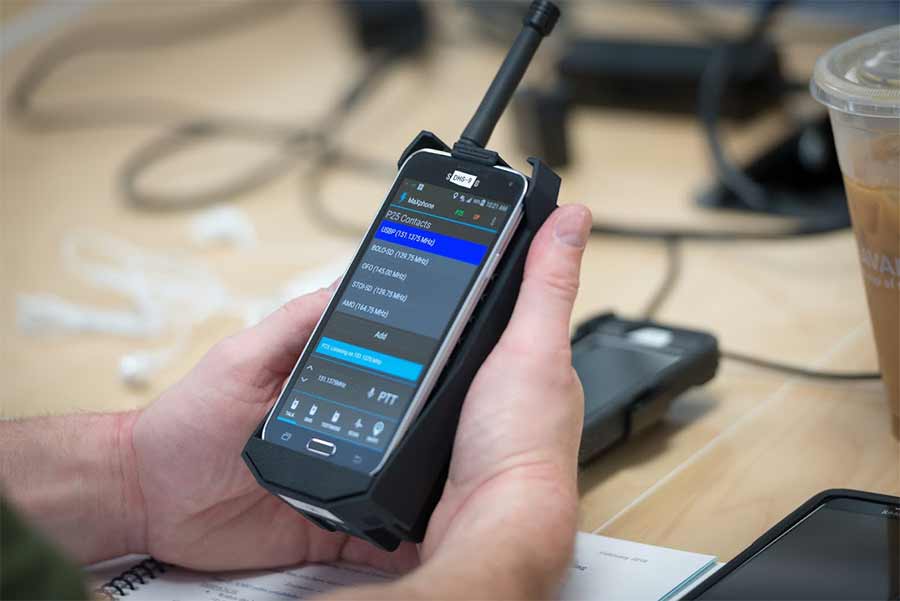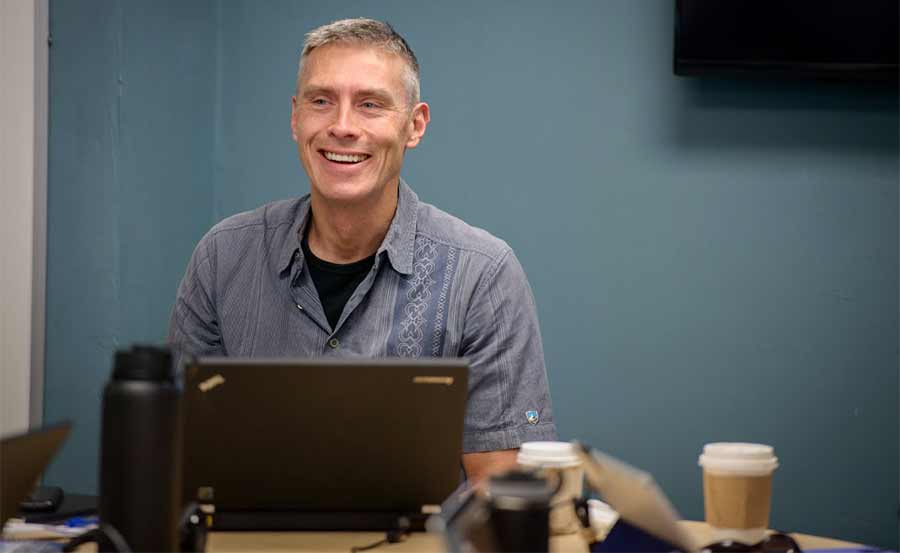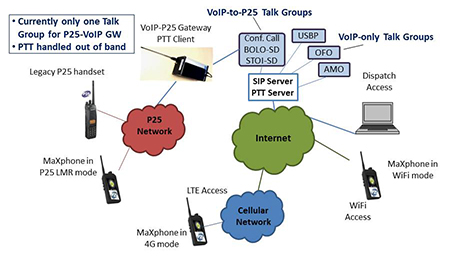
UC San Diego, MaXentric Develop MaXphone to Bridge Handheld Radios and Smartphones
Published Date
By:
- Tiffany Fox
Share This:
Article Content

The MaXphone MaXjacket fits over potentially any smartphone and, when paired with a custom app, can "convert" the smartphone into a land-mobile radio for use when cellular broadband networks aren't available. Photos by Alex Matthews/Qualcomm Institute.
For as high-tech as Department of Homeland Security operations have become (think ground-penetrating radar and predator drones), radio communications for the federal agency remain entrenched in the previous century. Customs and Border Protection agents, for example, alternate between cell phones and handheld radios depending on the availability of broadband commerical networks—a cumbersome approach that may require switching between technologies in the midst of sometimes tense scenarios.
But researchers from the University of California, San Diego Qualcomm Institute, in collaboration with MaXentric Technologies, are hoping a new technology that bridges legacy land-mobile radio (LMR) and LTE cellular networks will provide the upgrade the Department of Homeland Security needs to improve performance, reliability, security and interoperability, for a low price.
Known as the MaXphone (or officially, Multi-Access Extension for Smartphones), the prototype device consists of a plastic sleeve or “MaXjacket” that fits over potentially any smartphone. The user can use the smartphone just as he or she ordinarily would, or use the MaXphone’s custom-designed app to “convert” the phone into a land-mobile radio. The app does this by controlling the radio hardware inside the MaXjacket and connecting to the LMR standard network known as P25. It does this via voice-over-IP or VOIP, essentially setting up a conference call.
“The hardware developed for the MaXjacket runs an open-source software defined radio (SDR) version of P25,” said Per Johansson, Vice President of Engineering at MaXentric, lead principal investigator on the project and a principal development engineer at the Qualcomm Institute. “The open-source SDR approach gave us a lot of design flexibility and access to all parts of the radio.

Per Johansson
Added Johansson: “One of the key aspects of this device that makes it different from any other solution is that it provides the opportunity to develop apps for the LMR radio. There are other potential apps that could utilize the P25 voice services – you could write an app that sends simple GPS data, for example, such as when a firefighter is fighting a fire where there’s no 4G coverage.
“What we’ve done is open up the LMR radio to the same revolution smartphones have undergone,” he continued. “Before your cell phone was a smartphone you could do very few things with that phone. Then came app development, which changed everything. Your smartphone is nothing without the apps. It’s one thing to have a network, but the more important thing is to do something on the network. On the LMR side, as far as I know that’s never happened until now.”
Co-PI Curt Schurgers, a principal development engineer and director of the Wireless Systems Laboratory at the Qualcomm Institute, likens the MaXphone to a bridge that connects two parallel highways.
“Cellular and P25 are access technologies. They’re like on-ramps that allow you to get onto a specific network. Before now, we didn’t have a way to get from one network to the other using the same device,” he said, noting that QI researchers Anthony Nwokafor and Justin Bell were the key software developers on the QI side, shouldering the technical load.
The MaXphone’s combined hardware-software package was unveiled at the MaXentric offices during a two-day review earlier this month with representatives and agents from Customs and Border Protection (CBP), a branch of the Department of Homeland Security (DHS). The objective of the “talk-through, walk-through and run-through” test was to determine how effective and efficient the MaXphone would be if used during daily activities at the international border or ports-of-entry.
“CBP is a very diverse organization in terms of what our agents and officers are facing,” noted CBP Program Manager Emily Lattanzi, who attended the review. “What someone is facing on the northern border can be the polar opposite in terms of challenges seen on the southwest border with Mexico, which may vary widely from someone in an airport in middle America. But what I can say is that our guys in rural and remote areas are heavily dependent on the LMR networks. They’re in areas where broadband networks don’t reach, and what the LMRs provide is the number one thing that our guys need: Mission-critical voice communication.”

CBP, working with the DHS Science and Technology Directorate (S&T), contracted with three separate companies – MaXentric, Elbit Systems of America, and Interop Solutions – to develop an approach to combining LMR with LTE smartphones. Johansson noted that similar units developed by other vendors exist, but are cost-prohibitive: some units cost upwards of $7,000 and, unlike the MaXphone, may not allow the capability to talk via the P25 network if the smartphone goes outside 4G or WiFi coverage.
MaXentric, which has proven expertise in developing high-speed wireless technologies, high-power amplifiers and signal processing for both the Department of Defense and NASA, spent the first six months of the project working with the researchers at the Qualcomm Institute to create a proof-of-concept MaXjacket the size of a lab bench.
“In one year we got it down to one single board solution that sits in the current MaXjacket prototype, which is a remarkable effort,” noted Johansson.
“Tactical Communications in the field, whether via LMR or in the future a combination of LMR and LTE, are a lifeline for federal agents and officers and is critical for their safety and the success of missions and operations,” Lattanzi said, adding that the researchers from UC San Diego and MaXentric “made amazing progress” in terms of developing a working prototype.
“MaXentric was one of our smaller bids and they had nothing more than a white paper at the time of the proposal," she continued. "Unlike the other vendors, they didn’t already have a working prototype but they knew what was feasible. The first version of the MaXphone was originally on a breadboard and weighed four times more than the final product. They really came a long way to produce a functional prototype.”
The UC San Diego and MaXentric researchers consider the project a success, says Johansson, “because we did something which was quite unique – we showed you can do a lot more with this type of LMR radio, and we did it entirely with open-source software, meaning we didn’t pay for any software and in many cases, we didn’t change anything in the open-source code we used. We showed it could be something disruptive – none of the other performers built new hardware or a new radio.
"It’s been a very interesting and exciting journey working on this project,” added Johansson. “The MaXphone is one of the most novel approaches we’ve seen so far, and it’s been an amazingly successful prototype.”
From the perspective of the university, “this is a new form of technology transfer,” said Qualcomm Institute Director Ramesh Rao, who is lead principal investigator on the project for UC San Diego.
“Researchers at our institute have experience in the development of apps, radios and power amplifiers, and MaXentric benefits because they can pay our researchers at university wages. This approach to development is what makes our institute so unique.”
Share This:
You May Also Like
Stay in the Know
Keep up with all the latest from UC San Diego. Subscribe to the newsletter today.


